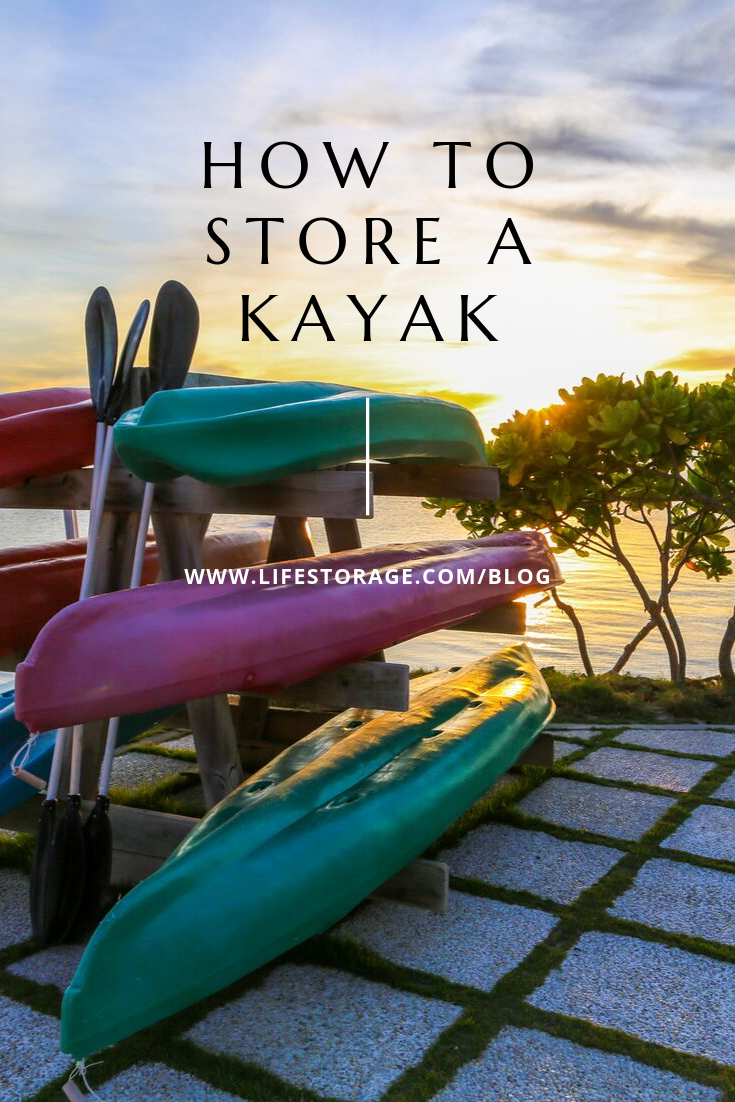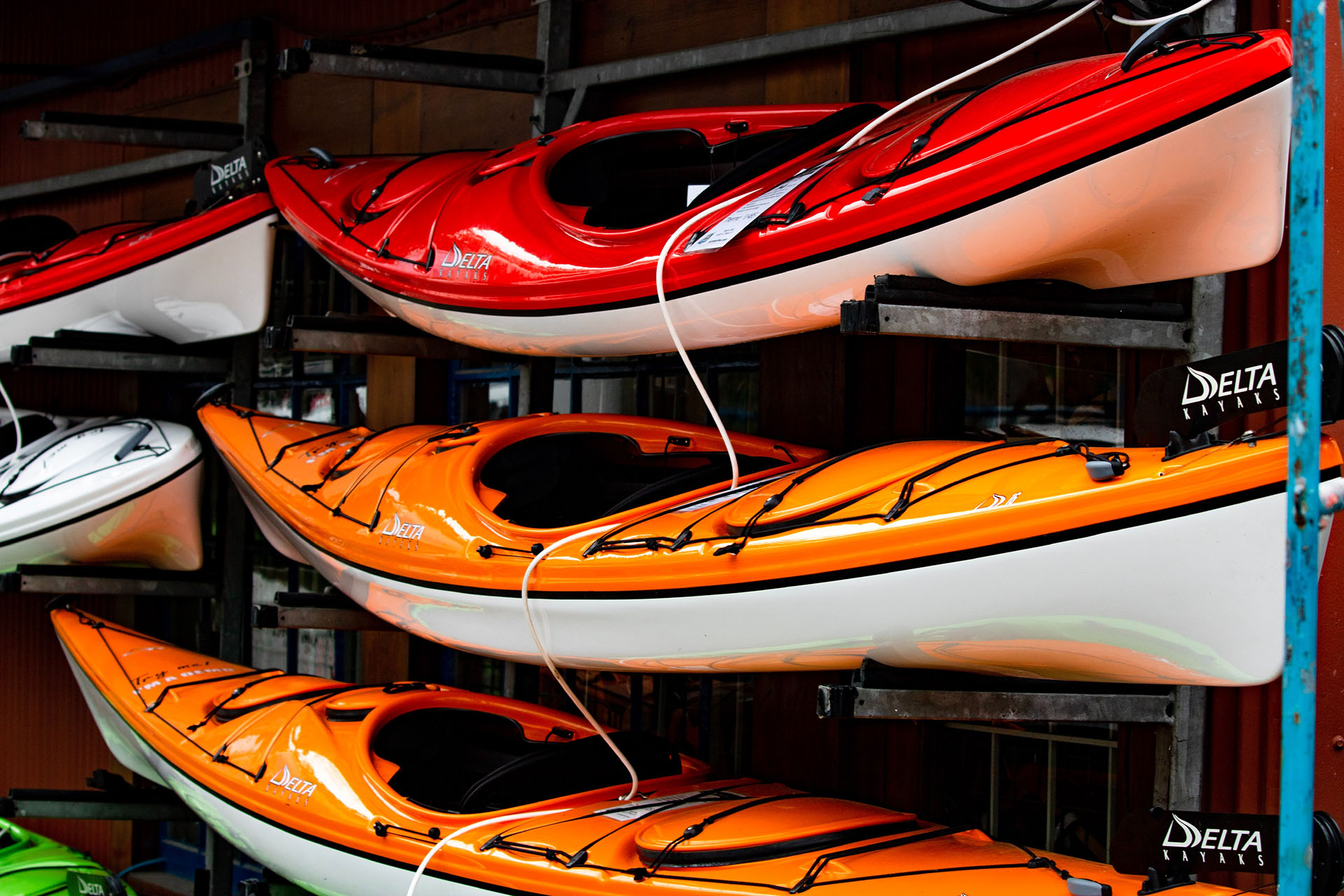
Think about your perfect summer day. Does it include spending an afternoon soaking up the sunshine and paddling on the water? Maybe it involves traveling to different State Parks and waterfronts near your city and exploring the great outdoors. If that’s the case, we’d wager a guess that kayaking is one of your favorite warm-weather activities.
Whether you’re already an avid outdoor adventurer or just starting to dip your toes into the kayaking world, consider buying your own watercraft. But before you do, it’s important to think about the less glamorous aspects of kayak ownership: where and how to store a kayak.
Most people don’t know how to store a kayak, partly because doing so requires some forethought. The worst thing you could do with a kayak is to drag it to the side of the garage and leave it on the ground for the entire winter. Not only do you risk theft and pest infestations, but you may also cause permanent, irreversible damage that can leave your vessel unusable. That might sound a bit extreme, but unfortunately, this method of storage is pretty standard for first-time owners of kayaks, canoes, paddle boards, and other small boats.
If you need help getting started with proper kayak storage, you’re in the right place. Our helpful guide will teach you the most effective ways to store a kayak that will save space and minimize sagging, denting, and cracking.
How To Store a Kayak: A Step-by-Step Guide
During the summer months, when the kayaking season is at its peak, daily storage might be as simple as setting it on a sturdy outdoor storage rack near the water or inside your garage. Suppose you live on a lake or enjoy a relaxing vacation filled with outdoor adventuring. In that case, you probably won’t want to go through the trouble of putting it entirely away every night (especially if you plan on returning to the water the next morning!).
Full-standing kayak storage racks that can be set up indoors or outdoors are a great solution when deciding where to store your vessel in the short term. But when the off-season rolls around, it’s important to find the best way to store a kayak indoors to preserve the life of your kayak for years to come.
Where should I store my kayak long-term?
Ideally, all kayaks would be stored indoors or inside a garage. The key to kayak storage is keeping your boat away from pests, extreme weather conditions, and direct sunlight. Look around your garage and think about any open section of wall or ceiling that you can convert into a kayak storage spot. If you are having trouble locating enough room, consider renting a storage unit for a few months out of the year. A lot of storage facilities offer units you can drive your vehicle up to for easy loading and unloading. Depending on the length of your kayak, a 10×10 storage unit may work for you. You can also consider renting a 10×15 or a 10×20 unit for a little extra room.
For ideal kayak storage conditions, consider finding a space with a consistent temperature and humidity, like renting a monthly climate-controlled storage unit. An inconsistent environment can make the kayak more susceptible to moisture problems like mold and mildew. You could also run into plastic cracking if the air is too hot and dry.
Related: Guide to RV and Boat Storage in Self-Storage Facilities
Here Are Some of the Best Kayak Storage Options to Consider:
Option 1: DIY a Kayak Storage Space With Wood Planks
Place two wooden planks on the ground close to a wall and place the kayak right side up on the planks so that the weight is evenly distributed on each plank. Lift one side of the kayak, and lean it against the wall. The wall will help spread the load more evenly. Every month, rotate the kayak, so the other side is leaning on the wall. This is a great do-it-yourself option if you prefer storing kayaks in your garage.
Option 2: Kayak Storage Racks
Buy (or build!) a kayak storage rack to fit your boat’s specific size dimensions. These helpful storage racks are specifically designed for kayaks, allowing you to place the kayak at a slight tilt or upside down on evenly distributed beams.
Option 3: Kayak Storage Ceiling Hooks
Hang the kayak upside down using bars or straps anchored to the ceiling. Just be sure never to hang the kayak from the handles or rudder. The straps should wrap around the entire kayak.
Option 4: Kayak Storage Wall Racks
Strap the kayak to a wall. To do this, position the kayak in an upright position. Place the stern of the boat on a cushion on the ground. Wrap some straps or bungees around the kayak and anchor them to a stud in the wall. Be sure not to wrap the boat too tightly, and make sure the cockpit is facing out.
Kayak Storage Tip: Don’t Position the Kayak on a Hard Surface
Whether you’re storing a kayak indoors or outdoors, this step is crucial to remember. You should never leave a kayak on a flat surface for more than a few days. The hull could become crushed and flattened over time from the excess weight placed on it. Remember: Kayaks are not meant to sit directly on their hull for an extended period of time. They should only be stored on their side with proper support because their plastic exterior could get dented.
Related: Storage Tips for Jet Skis, Snowmobiles, and Other Seasonal Toys
Do I need to clean my kayak before storing it indoors?
A well-used kayak will likely have its fair share of dirt, bugs, and residue that should be cleaned before the boat is stored. Move the kayak to a shady location and complete the following cleaning procedure.
How to Clean a Kayak for Storage:
- Remove any fabric sections like seat cushions or storage compartments. Clean these separately in the washing machine on a gentle cycle. Line-dry these components and store them separately.
- Spray the kayak with a mixture of mild detergent and water. Buff the bubbles into the boat using a long scrub brush.
- Rinse off the kayak with a hose, being sure to get into every nook and cranny.
- Open the drainage plug and empty any standing water. Be sure that any excess water is wiped down.
- Bring the boat back into a sunny location and allow the boat to dry completely. Remember to open any storage spaces so they can dry.
What if I can’t store my kayak indoors?
Here’s the issue with finding indoor kayak storage at home: Bulky kayaks rarely fit in a garage. Depending on the size of your garage (if you’re lucky enough to have one!), your kayak might not fit alongside your vehicle and anything else you decide to store in there. It’s also challenging to move a kayak into a basement or attic, and hard to prevent mildew, mold growth, and pest infestations in these areas.
Sound like a familiar problem? With obstacles like a lack of space, no available garage or basement area, and the inability to fit your kayak indoors, it’s no wonder that many owners need to make do with outdoor kayak storage. But don’t let that stop you from living your best kayak life! Storing a kayak outdoors is completely fine and totally safe, so long as the boat is prepared correctly beforehand.

Related: 12 Seasonal Storage Solutions Everyone Should Know
How to Store a Kayak Outdoors
When it comes to storing a kayak outside, many people make the mistake of wrapping the entire boat in a tarp and plopping it outside. The problem with this is that moisture can get underneath the tarp and cause the kayak to get musty. (That won’t be a fun experience to deal with when kayak season starts up again!)
If you plan to store your kayak outdoors during the off-season, don’t wrap it too tightly with a tarp. Instead, create a sheltered area where you can store the kayak under. A simple way to do this is to create a tent-like structure using a tarp and some PVC pipe. The tent shape lets any rain or excess water drain right off the sides of the tarp, leaving your kayak protected and untouched.
To protect the inside of your kayak from rodents or pests, pay close attention to the cockpit. Consider purchasing a specially made cover that tightly wraps around this area. Toss in some moisture-absorbing packets before sealing off the interior with a cover.
Crucial Tips for Outdoor Kayak Storage
- Remove any fabric seating or compartments and store these components separately. Anything with fabric can get infiltrated with bugs or rodents.
- Store the kayak off the ground on a designated rack.
- Protect the kayak from direct sunlight. Too much exposure can damage the exterior and warp the kayak.
- Don’t forget to lock the kayak to a secure structure like a garage or shed. Also, store the kayak out of sight, like behind the garage.
- Remember that direct exposure to UV light can cause unexpected damage and color fading. Always store your kayak in a shaded or covered area.
- Never leave a kayak flat on the ground for an extended period. Doing so could result in the kayak becoming warped or misshapen.
How Will You Use These Kayak Storage Ideas?
It’s no secret that a kayak isn’t a small purchase. That’s why as a kayak owner, you want to ensure your vessel lasts as long as possible so you can enjoy it for years to come. Learning how to store a kayak properly is one of the best ways to preserve your kayak during the off-season and beyond. We hope this kayak storage guide presented some helpful tips and storage options to help you determine the best route for your unique situation. Good luck!
Update: This post was originally published on September 30th, 2019, by Lauren Thomann and was revised again on March 28th, 2023, with further information from Emily Malkowski.